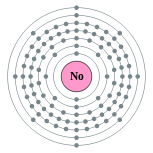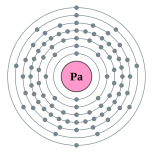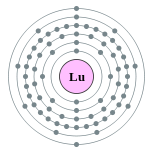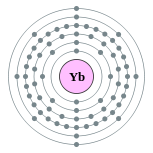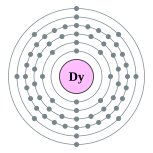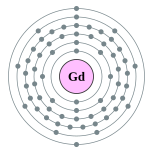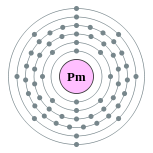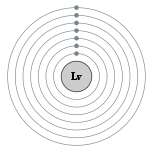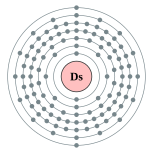Plutonium
| General properties |
| Name, symbol, number |
plutonium, Pu, 94 |
| Element category |
actinide |
| Group, period, block |
n/a, 7, f |
| Standard atomic weight |
(244) |
| Electron configuration |
[Rn] 5f6 7s2
2, 8, 18, 32, 24, 8, 2

|
| History |
| Discovery |
Glenn T. Seaborg, Arthur Wahl,
Joseph W. Kennedy, Edwin McMillan (1940–1) |
Plutonium is a transuranic radioactive chemical element with the symbol Pu and atomic number 94. It is an actinide metal of silvery-gray appearance that tarnishes when exposed to air, forming a dull coating when oxidized. The element normally exhibits six allotropes and four oxidation states. It reacts with carbon, halogens, nitrogen, and silicon. When exposed to moist air, it forms oxides and hydrides that expand the sample up to 70% in volume, which in turn flake off as a powder that can spontaneously ignite. It is also radioactive and can accumulate in the bones. These properties make the handling of plutonium dangerous.
Plutonium is the heaviest primordial element by virtue of its most stable isotope, plutonium-244, whose half-life of about 80 million years is just long enough for the element to be found in trace quantities in nature. Plutonium is mostly a byproduct of nuclear fission in reactors where some of the neutrons released by the fission process convert uranium-238 nuclei into plutonium.
One utilized isotope of plutonium is plutonium-239, which has a half-life of 24,100 years. Plutonium-239 and plutonium-241 are both fissile, meaning the nuclei of their atoms can split when bombarded by thermal neutrons, releasing energy, gamma radiation and more neutrons. These neutrons can sustain a nuclear chain reaction, leading to applications in nuclear weapons and nuclear reactors.
Plutonium-238 has a half-life of 88 years and emits alpha particles. It is a heat source in radioisotope thermoelectric generators, which are used to power some spacecraft.Plutonium-240 exhibits a high rate of spontaneous fission, raising the neutron flux of any sample containing it. The presence of plutonium-240 limits a sample's usability for weapons or reactor fuel, and determines its grade. Plutonium isotopes are expensive and inconvenient to separate, so particular isotopes are usually manufactured in specialized reactors.
A team led by Glenn T. Seaborg and Edwin McMillan at the University of California, Berkeley laboratory first synthesized plutonium in 1940 by bombardinguranium-238 with deuterons. Trace amounts of plutonium were subsequently discovered in nature. Producing plutonium in useful quantities for the first time was a major part of the Manhattan Project during World War II, which developed the first atomic bombs. The first nuclear test, "Trinity" (July 1945), and the second atomic bomb used to destroy a city (Nagasaki, Japan, in August 1945), "Fat Man", both had cores of plutonium-239. Human radiation experiments studying plutonium were conducted without informed consent, and a number of criticality accidents, some lethal, occurred during and after the war. Disposal of plutonium waste from nuclear power plants and dismantled nuclear weapons built during the Cold War is a nuclear-proliferation and environmental concern. Other sources of plutonium in the environment are fallout from numerous above-ground nuclear tests (now banned).
Return to Periodic Table

